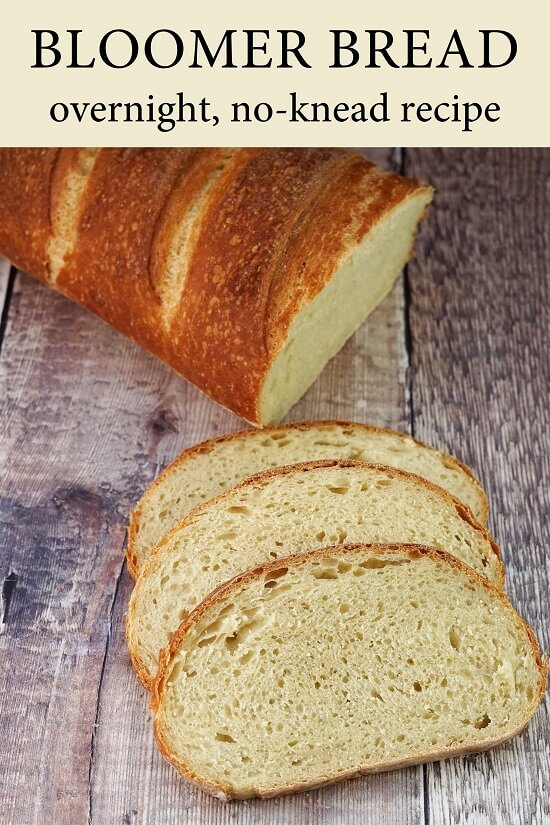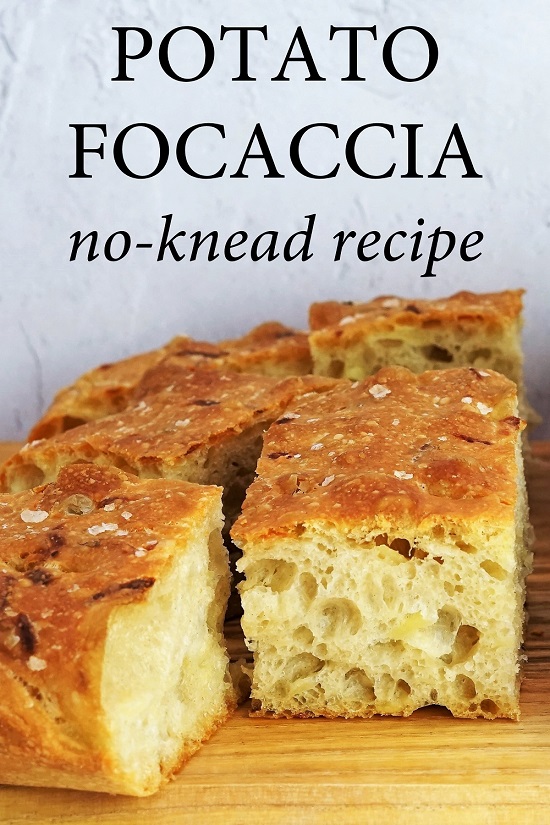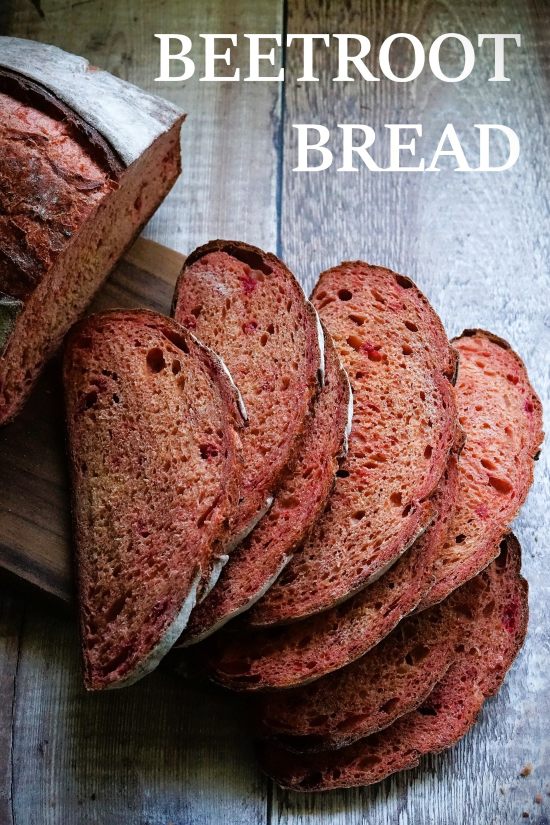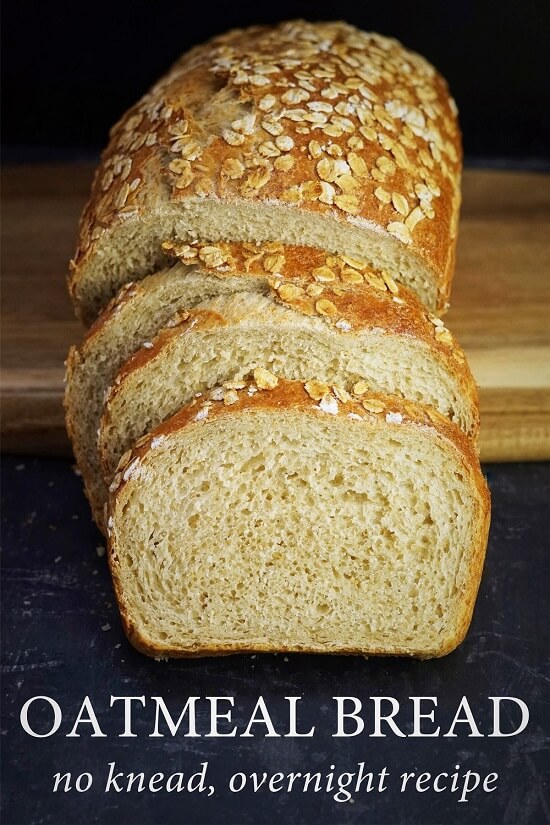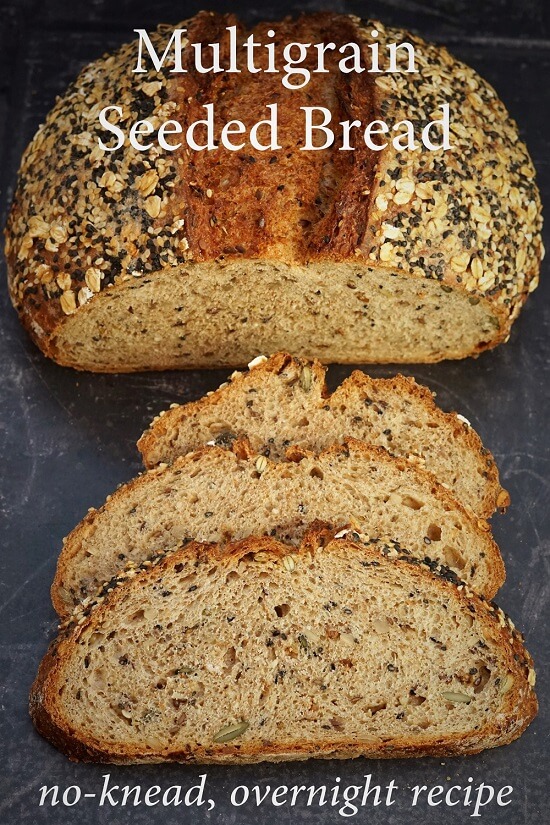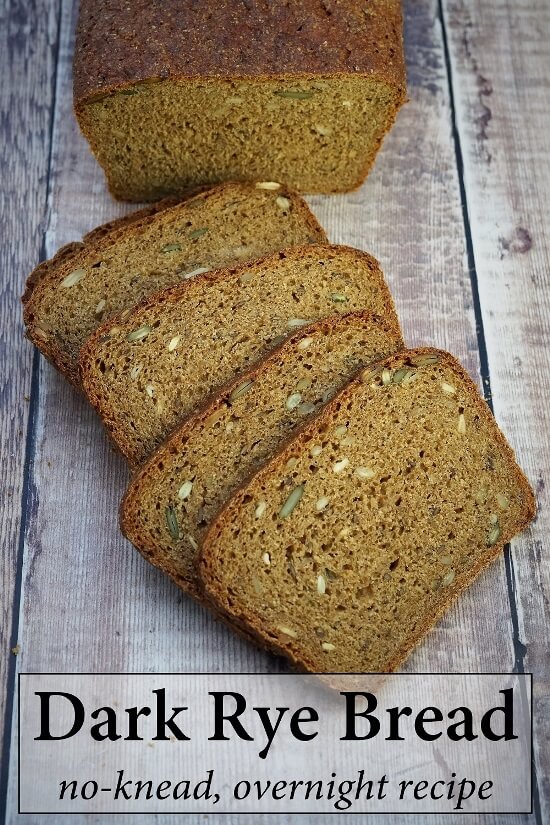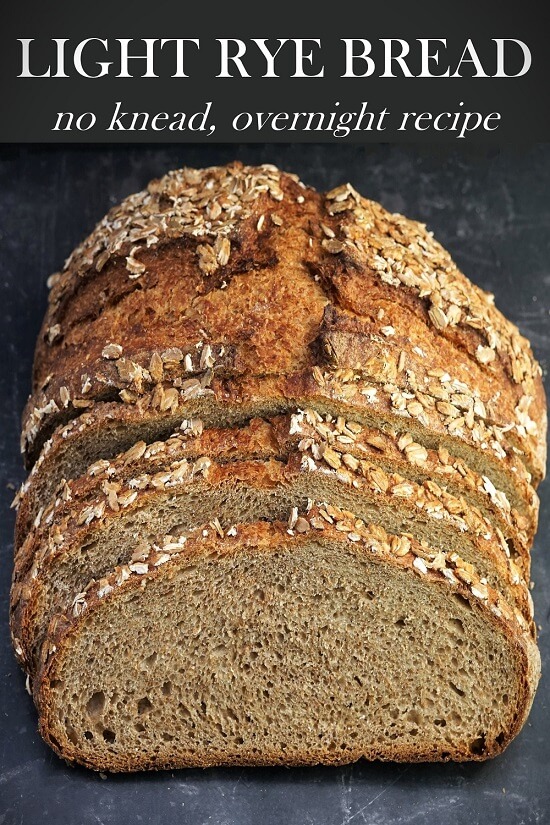Crusty Potato Bread (no knead overnight recipe)
Crusty Potato Bread has a soft and bouncy crumb that stays moist and fresher for longer. Easy to make with my no knead, overnight method, this substantial, tasty loaf is cooked in a covered pot for a great rise and crispy crust. Perfect for sandwiches, toast, or eating with soups.
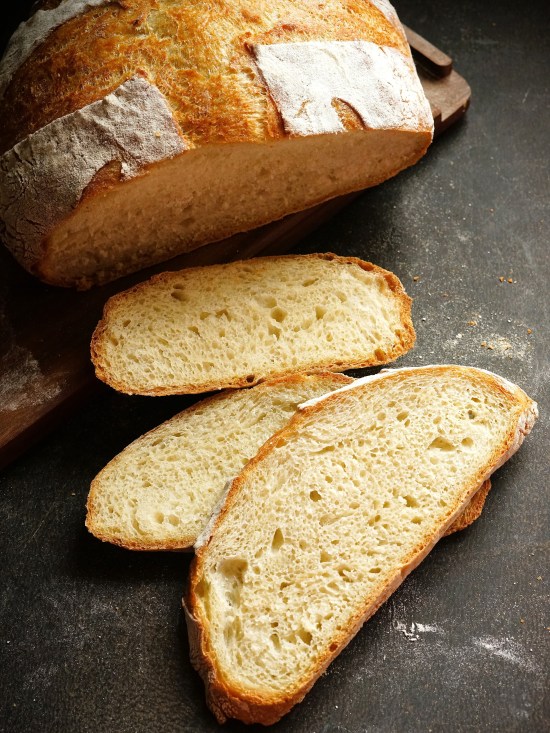
Disclosure: this post may contain affiliate links. If you buy via my links, I may earn a small commission at no extra cost to you.
Jump to Recipe
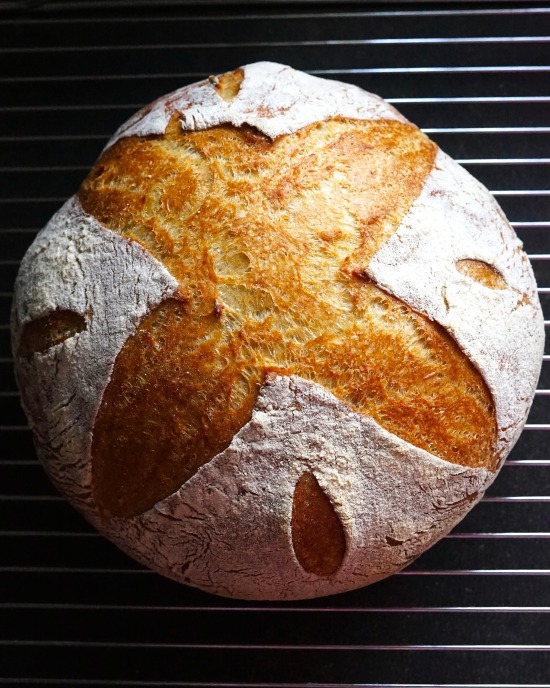
I’ve been meaning to post a dried yeast version of my no-knead, overnight Sourdough Potato Bread for some time. It’s a lovely moist and tasty loaf, so I thought it was well worth adapting for the wider audience who don’t bake with a sourdough starter. But I was finally prompted after experimenting with an entirely different root vegetable. I was so pleased with my Beetroot Bread that I quickly got back on the project.
The result was my new favourite white loaf: Crusty Potato Bread.
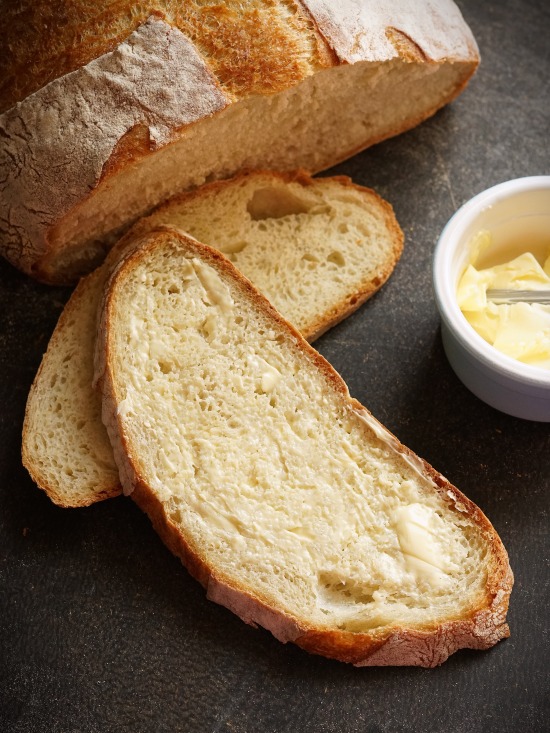
WHY ADD POTATO TO BREAD DOUGH?
In past times, potato was sometimes added to bread dough to eke out scarce wheat supplies. But today there’s still some great reasons to include potato in your loaves: to make them softer, moister, and to keep them fresher for longer. And how do they do this? By increasing the level of starch in your bread which means it can absorb and retain more liquid. The result is a more tender bread that will stale more slowly. Potatoes are a very starchy vegetable so are the perfect way to get the benefit of a higher starch dough.

In my Potato Focaccia I used grated raw potato which gave the freshly baked bread a lovely hint of roast potatoes. For my Sourdough Potato Bread and yeasted Crusty Potato Bread though, I’ve gone for mashed potato. I think this contributes extra complexity of flavour without tasting particularly potato-ey. It also seems more suitable for a finer crumb where strands of potato might be a little obtrusive.
NO-KNEAD, OVERNIGHT CRUSTY POTATO BREAD
My Crusty Potato Bread is based on the tried and trusted overnight no-knead loaf I make pretty much every week. Many years ago, I discovered that a wetter than usual dough combined with a long fermentation can replace the kneading of conventional bread making. This develops the gluten which helps doughs rise and gives bread its structure.

As potato doughs are notoriously sticky due to the additional starch, I think no-knead recipes are particularly suitable.
You’ll find a recipe card at the end with ingredient amounts and full instructions. But I recommend you first read the whole of this post for extra tips and step-by-step photos to guide you.
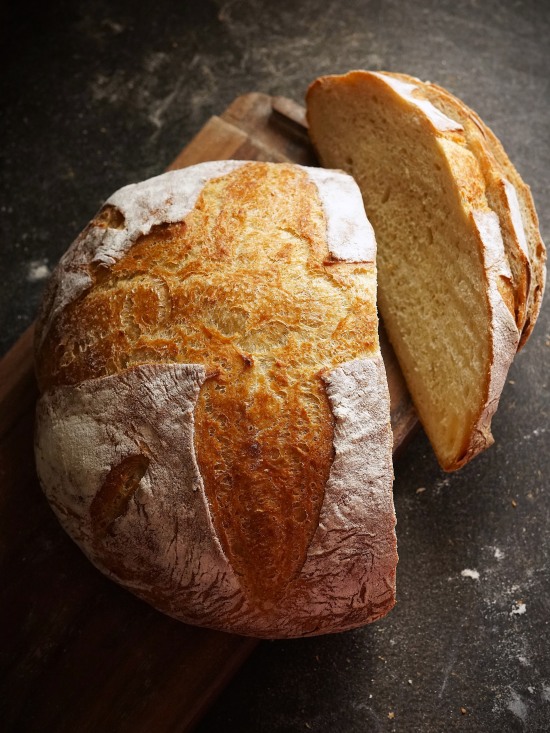
EQUIPMENT
You’ll need two essential pieces of equipment to make this bread: a heavy, lidded pot to bake it in and a proving vessel for the dough’s second rise. I’ve also listed the useful items I wouldn’t be without when making bread. The following links are paid links: if you buy via these, I may earn a small commission at no extra cost to yourself.
Essential #1: Heavy lidded pot. The interior gets incredibly hot and steamy which keeps the dough softer for longer as crust formation is delayed. The result should be an impressively risen loaf and crispy crust. The pot, including any handles or knobs, needs to withstand temperatures up to 240°C / 220° Fan / Gas 9 / 475° F.
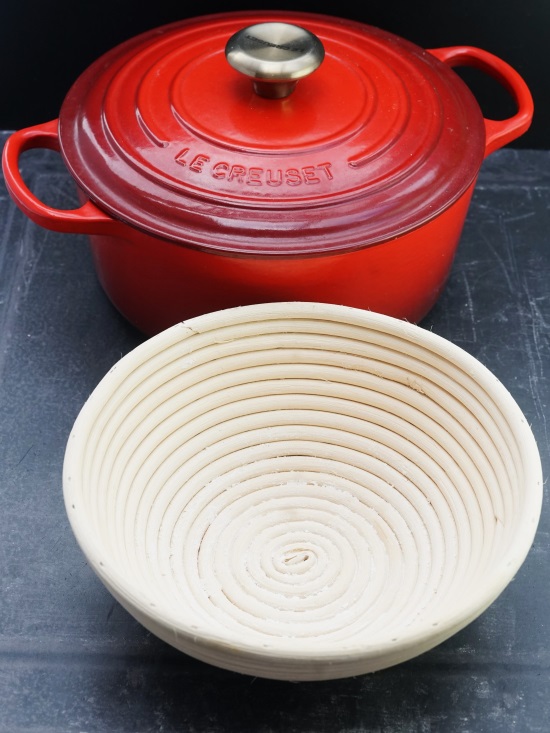
Although they’re expensive, I think Le Creuset pots are a great investment. They last for years (one of mine has been used for baking bread for over a decade) and can be heated to the required temperature. Of course, you may be able to find cheaper ones with similar properties, or you could use a Dutch oven. For my round Crusty Potato Bread I used my 24 cm Le Creuset which is also great for soups and stews. For oval loaves I have a Le Creuset 29cm / 4.7 litre oval casserole.
Essential #2: Proving vessel. Wetter doughs need support during their second rise or prove. Otherwise, they spread, and you will have a disappointingly flat loaf. While you can improvise with a suitably sized bowl or other container lined with a cloth, as I make bread almost every week I have baker’s baskets known as bannetons. These usually come with a liner but can be used with or without. For round loaves I use a 23 cm diameter banneton. For oval loaves I have a 25 cm long basket.
Optional but highly recommended:
Silicone spoon Much better than a wooden spoon when stirring up wet, sticky doughs.
Silicone mat A simple bit of kit useful for all sorts of baking, not just breads. You need less flour to prevent sticking, and it makes cleaning up easier too.
![]()
Dough scraper Very cheap to buy (you sometimes get one free with the silicone mat above), a scraper makes handling dough and removing it from bowls and worksurfaces much easier, especially wetter, stickier doughs.
Baker’s blade Because breads often split as they rapidly rise in the oven, we slash the dough to control where this happens. You could use a sharp knife, but a lame or grignette (basically something to safely hold a razor blade) is much more effective.
INGREDIENTS
The base ingredients you’ll need for my Crusty Potato Bread are the same as for my regular, overnight no-knead loaf.
- strong white bread flour: has better gluten-forming properties than plain/all-purpose flour.
- instant dried yeast: i.e. the sort you add to the rest of the ingredients without having to first activate in warm liquid.
- salt: gives structure to dough as well as enhancing flavour.
- water: the only difference here is that I use the potato cooking water instead of plain tap water. The potatoes leach out starch into the water as they cook, so we can take advantage of that too.
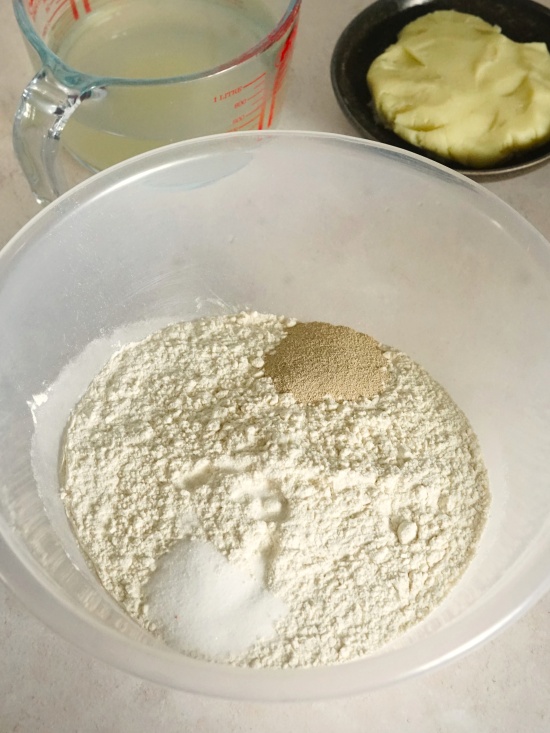
THE POTATOES
You probably already know that the best potato to use for mash is a floury variety rather than waxy. Waxy potatoes hold their shape (and would end up gluey if you tried to mash them) but floury go fluffy. For my Crusty Potato Bread I’ve used Roosters, but Maris Piper, King Edward or Russet are all good choices.
If, like me, you normally include butter and milk when making mashed potatoes, it’s better NOT to use leftovers in this bread. The extra ingredients mean you won’t get the same result, so please use potatoes prepared as per the recipe card.
THE NIGHT BEFORE BAKING CRUSTY POTATO BREAD
The mashed potatoes and their cooking water need to cool before we incorporate them into the dough, so making them is the first job. I add half a teaspoon of salt to the cooking water so they’re seasoned, but slightly reduce my usual amount added to the flour.
I know from frustrating experience that it’s very easy to forget to save the cooking water and just drain the potatoes as normal over the sink! So now, as soon as the potatoes go on to boil, I put a sieve over a jug to remind me.

You’re going to need around 375 – 400 ml of cooking water for the recipe. But the amount you’ll use to cover and cook the potatoes is likely to be much more than this anyway. For example, after draining I had almost 600 ml of cooking water.
The potatoes should be completely tender without falling apart. When done and drained, leave them in the sieve or colander for a few minutes to allow any surface water to evaporate. Then you can go ahead and mash them. You could put through a sieve or potato ricer but, cooked sufficiently, I found mashing with the back of the spoon was fine.
MAKE THE DOUGH
To make the dough, put the flour, salt and yeast into a large mixing bowl and stir. Now add the cold mashed potato, 250 ml of the cooled cooking water, and start stirring with your silicone spoon. Bring the ingredients together, gradually adding more water as necessary to create a dough with no dry flour visible. Try not to make the dough too wet: use the final image below as a guide.
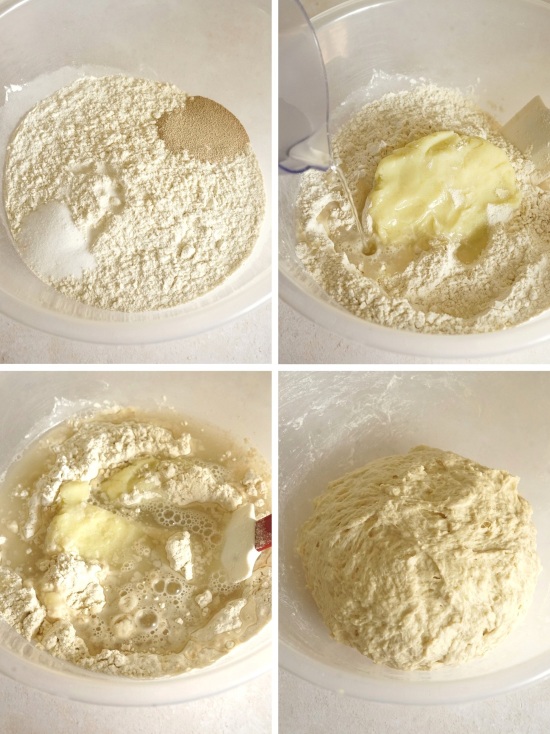
Now cover the dough (I put the whole thing in a large, reusable polythene bag) and leave overnight. Normal room temperature is usually fine, although the natural sugars in potato means this dough is likely to ferment more quickly. If necessary (or if it’s just more convenient) you can do the overnight fermentation in the fridge. For the Crusty Potato Bread you see in the post, I gave it 3 hours at room temperature then put in the fridge for the rest of the night.
THE NEXT DAY
In the morning, the dough should have spread out as well as rising and be VERY bubbly. If not, leave a little longer. Sprinkle your work surface (ideally covered with a silicone mat) with bread flour then scrape the dough onto it. Fold the dough over itself several times (use a scraper if you can) until smooth. You may need to add more flour as you go depending how wet and sticky your dough is.

Cover with the upturned bowl and leave to rest for 10 minutes.
We now give the dough some stretches and folds. This helps build structure. Use a hand to lift the top edge (I think of it as north) then fold it into the middle. Repeat the process with the east, south, and west sides. Repeat the process twice more to get a plump piece of dough. If the dough still seems quite wet and loose, you may need to add more flour and/or repeat the folds.
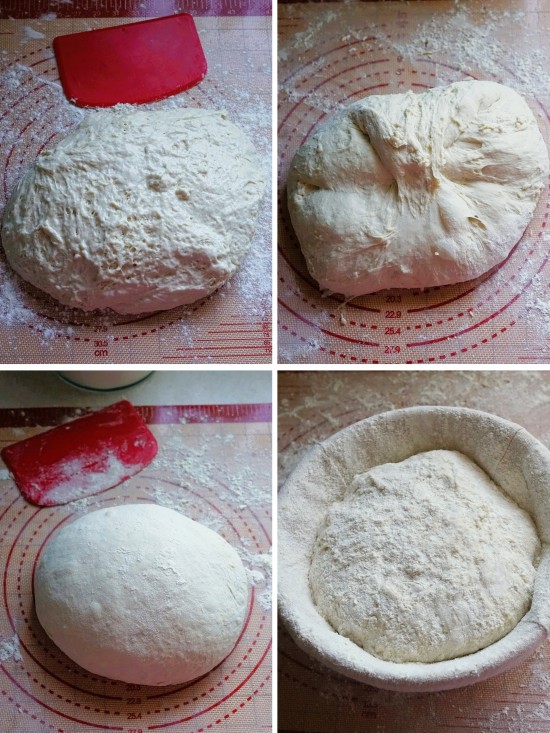
Generously sprinkle flour into your lined banneton or improvised equivalent. Now fold the dough again, this time shaping it to fit the banneton. Sprinkle more flour over the dough, spreading it with your hand, then put it in so the rounded top is now facing DOWN. Dust the side that’s facing up with flour, put the whole thing back in the large polythene bag or cover it.
For the second rise or prove, ideally put it in a warmer spot. During this time, you should also preheat your oven to the temperature shown in the recipe card. Be sure to put in the cooking pot and its lid to preheat too.
BAKING CRUSTY POTATO BREAD
Depending on temperature, the prove should take 30 – 45 minutes. The dough may or may not almost double, but the best way to check if the dough is ready is to gently insert a finger. Does the dough quickly or slowly spring back? If it springs back slowly and an impression is left by your finger, then the dough is ready. If it springs back immediately and doesn’t leave an impression, prove for longer then check again.
When ready to bake, remove the pot from the oven and take off the lid. Carefully flip the dough into the pot so that the round side is facing UP. Use a blade or knife to slash a cross (or your preferred pattern) on top of the bread. Put the lid back on, transfer to the oven and bake for 35 minutes.
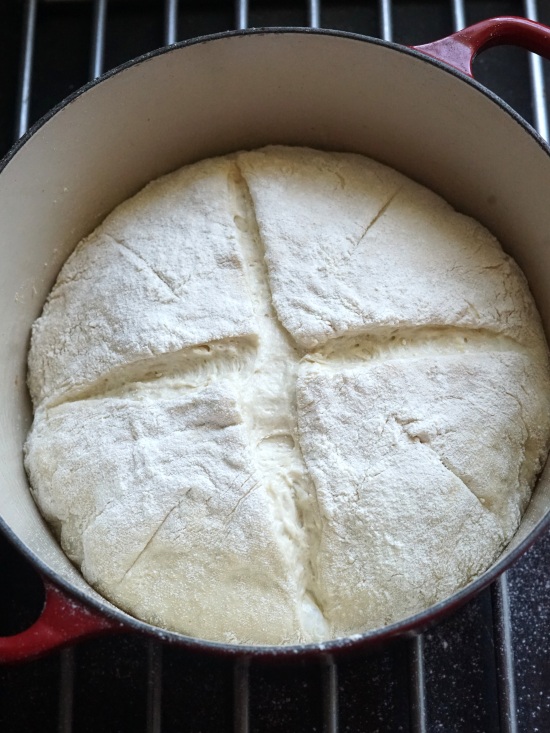
After 35 minutes, reduce the oven temperature to that shown in the recipe card. Remove the pot from the oven and take off the lid. Tip it out of the pot then return the loaf to the oven so it sits directly on the shelf.
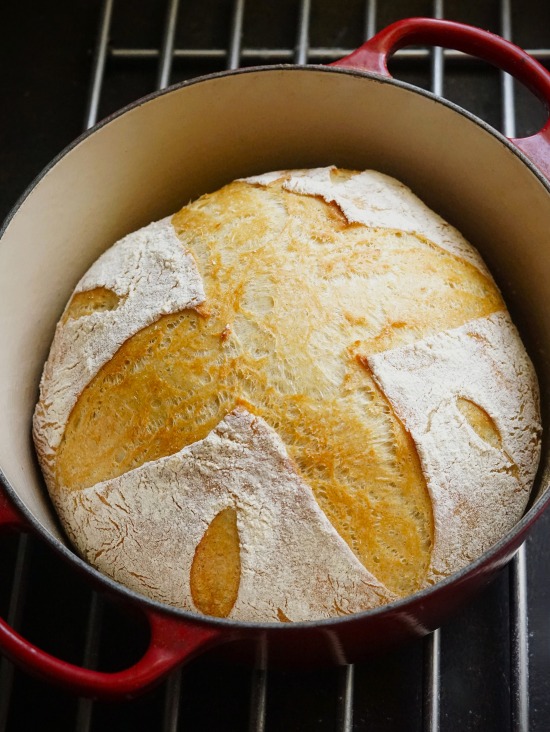
Bake for a further 12 – 15 minutes or until the bread is cooked through: it should sound hollow when you tap it underneath. Place the loaf on a wire rack until completely cold before slicing.

CRUSTY POTATO BREAD: A CLASSIC MADE EVEN BETTER
For me, a slice of fresh, home baked crusty white bread spread with plenty of butter always feels like a treat. How something so simple can be utterly delicious and satisfying is one of life’s real pleasures. And once you learn that adding another everyday ingredient, potatoes, can give it even more flavour, softness, and moistness, you realise that it really is possible to improve on a classic.

I think this rustic style loaf is perfect for other classics like bread and jam, with boiled eggs, or in cheese or ham sandwiches. I love it with some of my old-fashioned favourites like Haslet (delicious pork and sage English cold meatloaf) and Homemade Potted Beef
A hunk of Crusty Potato Bread is also lovely alongside soup, and makes wonderful crunchy toast. It should keep fresh for at least three days and freezes well: I slice it first so I can take out as much as I need without waste.
If you’ve made this recipe, I’d love to know how it went. Please do please leave a comment and rating.
If you share your photos on Facebook or Instagram please tag @moorlandseater
GET RECIPES STRAIGHT TO YOUR INBOX BY JOINING MY EMAIL LIST HERE

Crusty Potato Bread (no knead overnight recipe)
The soft and bouncy crumb of this loaf stays moist and fresher for longer thanks to extra starch from mashed potatoes incorporated into the dough. Cooked in a covered pot for a great rise and crispy crust, the substantial, tasty loaf is perfect for sandwiches, toast, or eating with soups.
It's recommended you read the accompanying blog post and the Recipe Notes below before starting to cook. Use digital scales and metric measurements as these were used to test the recipe.
Ingredients
- 250 g peeled potatoes (a floury type suitable for mashed potatoes e.g. Rooster, King Edward, Maris Piper)
- water (for cooking the potatoes)
- salt (see instructions for amounts)
- 600 g strong white bread flour (plus extra for dusting)
- 1.5 tsp (7g) instant dried yeast (i.e. the type that does not need activating before adding to the rest of the ingredients)
Instructions
The day before baking
-
Wash the potatoes and cut into medium dice.
Put in a saucepan, cover with cold water and add ½ tsp salt.
Bring to the boil then turn down to a medium simmer. Cook until completely tender but not falling apart (approx. 12 - 15 min).
Drain over a bowl or jug to collect the cooking water then leave the potatoes in the sieve or colander for a few minutes to allow any surface water to evaporate.
Set the potato cooking water aside until it reaches room temperature. Meanwhile, mash the potatoes or put them through a sieve or ricer so they're smooth. Leave to cool.
-
Put the bread flour, 1½ tsp salt, and the instant yeast into a large mixing bowl and stir to combine.
Add the cold mashed potatoes and 250 ml of the cooled cooking water then start stirring with a silicone spoon to bring the ingredients together, gradually adding more of the cooking water as necessary to form a dough with no dry flour visible. Try not to make the dough too wet as the potato may release more water.
-
Cover the dough and leave to ferment at room temperature overnight.
Tip: the natural sugars in potato means the dough is likely to ferment more quickly, especially if the room is warm. If necessary, you can do the entire ferment in the fridge or leave it at room temperature for a few hours then put in the fridge overnight.
On the day of baking
-
The dough should have risen, spread out and be very bubbly. If not, leave a little longer.
Dust flour over your work surface, ideally covered with a silicone mat, and use a dough scraper to transfer the dough onto it. Fold over itself several times until smooth: add more flour as needed to prevent sticking.
Cover the dough with the upturned bowl and leave to rest for 10 minutes.
-
To help create structure: stretch and fold the dough by lifting up the top edge (think of it as 'north') then folding it into the middle. Repeat with the 'east', 'south' and 'west' sides. Add more flour as necessary to prevent sticking.
Repeat the process at least twice more until you have a plump piece of dough.
Tip: if the dough still seems wet or sticky, add more flour as you fold.
-
Sprinkle a generous amount of flour inside a lined banneton (or an improvised proving vessel such as a bowl lined with a tea towel).
Fold the dough again, this time shaping it to fit your proving vessel. Sprinkle the top with more flour then put it in the vessel with the rounded side facing DOWN. Dust the side now facing up with more flour.
Place in a large reusable polythene bag or cover it and leave in a warm place for approximately 30 - 45 minutes.
While it's proving: preheat your oven to 240°C / 220° Fan / Gas 9 / 475° F and put a lidded cast iron pot or Dutch oven on the middle shelf.
-
Check if the dough is ready to bake: gently insert a finger into the dough and see if the dough quickly or slowly springs back.
- If the dough springs back slowly and leaves an impression, it's ready.
- If it springs back immediately and doesn't leave an impression then prove another 5 - 10 minutes and check again.
-
When ready to bake, remove the pot from the oven and take off the lid.
Carefully flip the dough into the pot so the rounded side is now facing UP.
Use a sharp knife, razor blade or baker's lame to slash a cross on top of the dough (or make your own preferred pattern).
Put the lid on the pot, place in the oven and bake for 35 minutes.
-
After 35 minutes, reduce the heat to 220° C / 200° Fan / Gas 7 / 425°F.
Remove the pot from the oven, tip the bread out of it, then return the loaf to sit directly on the oven shelf.
Bake for a further 12 - 15 minutes or until the bread is cooked through: it should sound hollow when tapped underneath.
-
Place on a wire rack until completely cold before slicing.
Best eaten within 3 days or can be frozen.
Tip: slice before freezing so you can take out as much as you need without waste.
Recipe Notes
Equipment (further info and partner links in the accompanying blog post)
- You'll need a heavy, lidded pot or Dutch oven in which to bake the bread. It should have a capacity of at least 3.5 litres.
- To support the dough on its second rise or prove, you'll need a banneton/proving basket or a large bowl lined with a tea towel or other cloth.
- The no-knead potato dough is wetter and stickier than normal, so a dough scraper and silicone mat are recommended for removing from the bowl and for folding/shaping.
RELATED RECIPES


